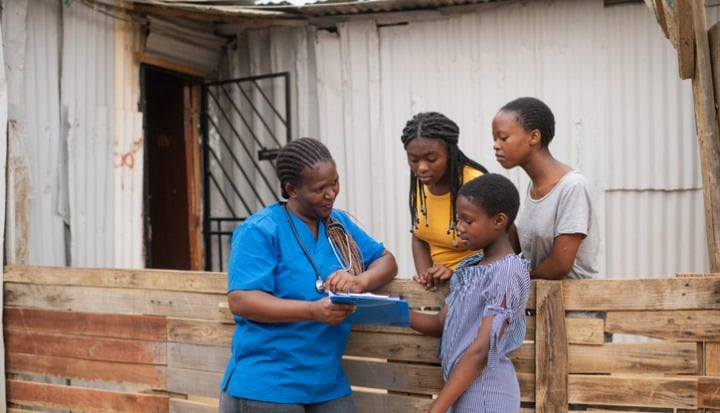Catalysing Investment in the Health of Women, Children, and Adolescents – Business Fights Poverty
Catalysing Investment in the Health of Women, Children, and ... Business Fights Poverty



Global Progress in Women, Children, and Adolescent Health Stagnates
Global progress to reduce preventable deaths of pregnant women, mothers, and babies has flatlined for the last eight years, according to the World Health Organization (WHO). It is high time to recognize that investing in the health of women, children, and adolescents is not only a moral imperative and a human rights requirement; it’s an essential investment in the future of communities and economies worldwide.
Stark Realities
When it comes to the health of women, children, and adolescents, the statistics are grim, particularly for those living in low-income countries.
- Over 4.5 million mothers and babies die each year from preventable conditions related to pregnancy and childbirth; on average, a woman dies in childbirth every two minutes.
- 270 million women and girls of reproductive age (15-49 years) cannot access contraception.
- Only 57% of women and girls make informed decisions on sexual relations, contraception use, and reproductive health care.
- Rates of forced and child marriage, gender-based violence, and teenage pregnancy remain high.
- Nearly 50% of deaths of children under 5 years of age are caused by malnutrition.
- 148 million children under five are affected by stunting.
The vast majority of this human suffering is preventable through improved access to healthcare, contraception, vaccination, and nourishment. The consequences of inaction are severe, not only for women, children, and adolescents but also for society and the wider economy. Women make up almost 40% of the global workforce and contribute the lion’s share of unpaid care work. Furthermore, good nutrition and health in early childhood support cognitive and physical development and are critical to building human capital and an individual’s future earning potential.
Investments in women, child, and adolescent health are an investment in prosperity, with the possibility to increase productivity, reduce absenteeism and health costs, and unleash human innovation and potential.
The Global Financing Facility
Understanding the pressing need for action, in 2015 the World Bank, health leaders, the United Nations, and civil society organizations created a new multi-stakeholder partnership, the Global Financing Facility for Women, Children and Adolescents (GFF).
The GFF’s unique, country-led model of financing has been critical to accelerating health investments and spurring health progress and empowerment for women, children, and adolescents in 36 low- and middle-income countries. Since its inception, $2 billion has been committed to the GFF Trust Fund by governments and other donors including the Bill & Melinda Gates Foundation, Susan T. Buffett Foundation, MSD for Mothers, and Laerdal Global Health.
These funds are being used to successfully unlock a further $30.2 billion of funds through linking grants to World Bank IDA and IBRD financing. GFF also leverages private sector capabilities to deliver services and raise private finance.
GFF’s coordination approach helps to reduce duplication of efforts and inefficiencies, whilst prioritizing the most impactful interventions that deliver tangible results. As a result of GFF’s catalytic investments and technical assistance:
- 96 million women have received four or more antenatal care visits
- 103 million women have delivered their babies safely
- 111 million newborns have benefited from early initiation of breastfeeding
- More than 500 million women have received access to modern family planning
- 187 million unintended pregnancies have been prevented.
The Role of the Private Sector
Companies are increasingly playing a crucial role in strengthening health systems and widening access to care, and the Global Financing Facility is leveraging the synergies between the private and public sectors.
One example is the “Innovation-to-Scale” competition led by GFF, Laerdal Global Health, and the Government of Norway. Out of 320 global entries, 5 projects won up to $5M each, focusing on areas like safe childbirth, neonatal care, and digital health. The Safer Births Bundle of Care (SBBC) received a $4.5m grant, enabling 1200 health workers to be trained across 30 district hospitals in high-risk regions of Tanzania. Due to its success, a further $8.5 million has been awarded by the GFF to expand to over 100 hospitals, potentially saving 25,000 lives a year.
Meanwhile, the GFF supply chain partnership with the Bill & Melinda Gates Foundation, MSD for Mothers, and the United Parcel Service (UPS) Foundation leverages private sector expertise in supply chains to develop innovative solutions to logistical challenges that prevent access to healthcare.
Delivering the Future
There is a role for all businesses to play in improving access to healthcare for women, children, and adolescents – whether through expertise in healthcare, pharmaceuticals, logistics, education, or digital innovation; by supporting women in companies and their value chains to access healthcare and health-related information; or leveraging the advocacy voice of the private sector to call for governments to prioritize this critical issue.
Over the next few months, Business Fights Poverty is partnering with the GFF and the Bill and Melinda Gates Foundation, in support of GFF’s #DeliverTheFuture campaign. The campaign seeks to raise a further $800m this year, to catalyze a further £20.5 billion of investment and reach 250 million women, children, and adolescents in LMICs with lifesaving care by 2030.
Our collaboration will ask, “What is the role of the private sector in supporting governments to deliver healthier futures for women, children, and adolescents?” It will explore how businesses can leverage innovation, partnership, novel financing, and their advocacy voice to accelerate action. We warmly invite you to participate, support the campaign, and get in touch with us to share your own work and insights in this area.
SDGs, Targets, and Indicators
1. Which SDGs are addressed or connected to the issues highlighted in the article?
- SDG 3: Good Health and Well-being
- SDG 5: Gender Equality
- SDG 10: Reduced Inequalities
- SDG 17: Partnerships for the Goals
2. What specific targets under those SDGs can be identified based on the article’s content?
- SDG 3.1: By 2030, reduce the global maternal mortality ratio to less than 70 per 100,000 live births.
- SDG 3.2: By 2030, end preventable deaths of newborns and children under 5 years of age.
- SDG 3.7: By 2030, ensure universal access to sexual and reproductive health-care services, including for family planning, information and education, and the integration of reproductive health into national strategies and programs.
- SDG 5.1: End all forms of discrimination against all women and girls everywhere.
- SDG 5.2: Eliminate all forms of violence against all women and girls in the public and private spheres, including trafficking and sexual and other types of exploitation.
3. Are there any indicators mentioned or implied in the article that can be used to measure progress towards the identified targets?
Yes, the following indicators can be used to measure progress towards the identified targets:
- Maternal mortality ratio (MMR)
- Neonatal mortality rate
- Child mortality rate
- Access to sexual and reproductive health-care services
- Prevalence of gender-based violence
SDGs, Targets, and Indicators
| SDGs | Targets | Indicators |
|---|---|---|
| SDG 3: Good Health and Well-being | 3.1: By 2030, reduce the global maternal mortality ratio to less than 70 per 100,000 live births. | Maternal mortality ratio (MMR) |
| SDG 3: Good Health and Well-being | 3.2: By 2030, end preventable deaths of newborns and children under 5 years of age. | Neonatal mortality rate Child mortality rate |
| 3.7: By 2030, ensure universal access to sexual and reproductive health-care services, including for family planning, information and education, and the integration of reproductive health into national strategies and programs. | Access to sexual and reproductive health-care services | |
| SDG 5: Gender Equality | 5.1: End all forms of discrimination against all women and girls everywhere. | N/A |
| 5.2: Eliminate all forms of violence against all women and girls in the public and private spheres, including trafficking and sexual and other types of exploitation. | Prevalence of gender-based violence |
Behold! This splendid article springs forth from the wellspring of knowledge, shaped by a wondrous proprietary AI technology that delved into a vast ocean of data, illuminating the path towards the Sustainable Development Goals. Remember that all rights are reserved by SDG Investors LLC, empowering us to champion progress together.
Source: businessfightspoverty.org

Join us, as fellow seekers of change, on a transformative journey at https://sdgtalks.ai/welcome, where you can become a member and actively contribute to shaping a brighter future.







